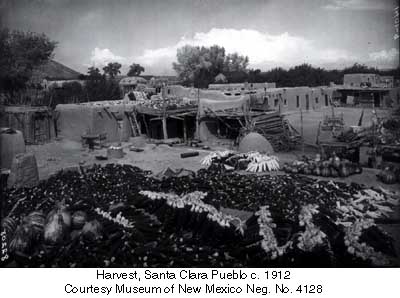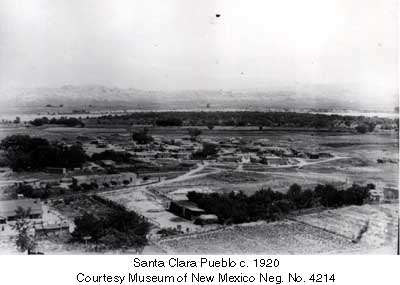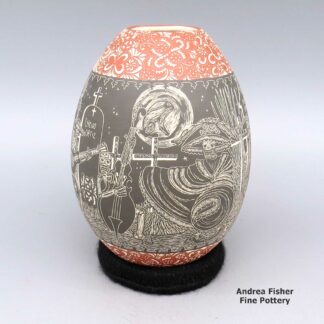| Dimensions | 6.5 × 6.5 × 8 in |
|---|---|
| Condition of Piece | Very good |
| Signature | -Lois- |
| Date Born | 1998 |
Lois Gutierrez, rwsc0k129: Polychrome jar with kiva step opening and koshares fishing and swimming design
$1,250.00
A polychrome jar with cut kiva step opening and a design with fish, raccoons and several koshares lounging, fishing and swimming
In stock
Brand
Gutierrez, Lois
Lois married Derek de la Cruz early in life and they've been working together since: Lois does most of the potting and painting while Derek works with the clay and helps with the firing. Lois and Derek are among the few potters still working at Santa Clara who are willing to search out and prepare the various colors of natural clay Lois uses on her pots.
One of their collaborations took the Best of Show ribbon at the Santa Fe Indian Market in 1982 and they were totally overwhelmed by the sudden increased demand for their pottery. They went to Santa Fe Indian Market a couple more times but chose more often to go to the New Mexico State Fair (and they've earned more than a few ribbons there, too).
Lois's specialty is painted polychrome pottery made the way it used to be at Santa Clara, before the carving and sgraffito processes took hold. Her designs are often depictions of scenes from pueblo life, adorned with appropriate traditional Santa Clara geometrics.
Some Exhibits that featured works by Lois and Derek
- Artistic Excellence: The Heard Museum Guild Indian Fair & Market Celebrates 60 Years. Heard Museum. Phoenix, Arizona. February 2, 2018 - August 31, 2018
- Images, Artists, Styles: Recent Acquisitions from the Heard Museum Collection. Heard Museum North. Scottsdale, Arizona. July 2001 - July 2002
- 1980 Heard Museum Guild Indian Arts and Crafts Exhibit. Heard Museum. Phoenix, Arizona. November 26 - December 3, 1980 Rising Stars. Gallery 10. Scottsdale, Arizona. February 8-27, 1980
- 1978 Heard Museum Guild Indian Arts and Crafts Exhibit. Heard Museum. Phoenix, Arizona. November 24 - December 2, 1978
- 1977 Heard Museum Guild Indian Arts and Crafts Exhibit. Heard Museum. Phoenix, Arizona. November 25 - December 3, 1977
- 1976 Heard Museum Guild Indian Arts and Crafts Exhibit. Heard Museum. Phoenix, Arizona. November 26 - December 5, 1976
Some Awards earned by Lois and Derek
- 1984 Santa Fe Indian Market, Classification II - Pottery, Division E - Traditional pottery, painted designs on burnished black or red surface, Category 1102 - Jars (over 8 inches tall): Second Place
- 1983 Santa Fe Indian Market, Katherine and Miguel Otero Award - Creative excellence in any category
- 1983 Santa Fe Indian Market, Classification II - Pottery, Division F - Traditional, painted designs on matte or semi-matte surface: Second Place
- 1982 Santa Fe Indian Market. Best of Show
- 1982 Santa Fe Indian Market, Best of Class - Pottery
- 1982 Santa Fe Indian Market, Classification Pottery, Best of Division
- 1982 Santa Fe Indian Market, Classification Pottery, Traditional Hopi, Zia, Acoma Style Pottery. Jars - Other Pueblos: First Place
- 1980 Heard Museum Guild Indian Arts and Crafts Exhibit, Classification VII, Pottery, Division A - Traditional construction and firing: Honorable Mention. Awarded for artwork: Large vase with fluted rim
- 1978 Heard Museum Guild Indian Arts and Crafts Exhibit, Best of Show. Awarded for polychrome bowl: "Hunter & Turkey"
- 1978 Heard Museum Guild Indian Arts and Crafts Exhibit: Heard Museum Board of Trustees Best of Crafts. Awarded for polychrome bowl: "Hunter & Turkey"
- 1978 Heard Museum Guild Indian Arts and Crafts Exhibit, Best of Pottery. Awarded for polychrome bowl: "Hunter & Turkey"
- 1978 Heard Museum Guild Indian Arts and Crafts Exhibit, Best of New Mexico Pueblo Pottery. Awarded for polychrome bowl: "Hunter & Turkey"
- 1978 Heard Museum Guild Indian Arts and Crafts Exhibit, Classification VII - Pottery, Division B - Contemporary: First Place. Awarded for polychrome bowl: "Hunter & Turkey"
- 1977 Heard Museum Guild Indian Arts and Crafts Exhibit, Classification VII - Pottery, Division B - Contemporary: Second Place. Awarded for artwork polychrome bowl
- 1976 Heard Museum Guild Indian Arts and Crafts Exhibit, Classification X - Pottery, Division B - Contemporary: Honorable Mention. Awarded for artwork: White bowl with rain dance design
A Short History of Santa Clara Pueblo

Santa Clara Pueblo straddles the Rio Grande about 25 miles north of Santa Fe. Of all the pueblos, Santa Clara has the largest number of potters.
The ancestral roots of the Santa Clara people have been traced to ancient pueblos in the Mesa Verde region in southwestern Colorado. When the weather in that area began to get dry between about 1100 and 1300 CE, some of the people migrated to the Chama River Valley and constructed Poshuouinge (about 3 miles south of what is now Abiquiu on the edge of the mesa above the Chama River). Eventually reaching two and three stories high with up to 700 rooms on the ground floor, Poshuouinge was inhabited from about 1375 CE to about 1475 CE.
Drought then again forced the people to move. One group of the people went to the area of Puyé (along Santa Clara Canyon, cut into the eastern slopes of the Pajarito Plateau of the Jemez Mountains). Another group went south of there to what we now call Tsankawi. A third group went a bit to the north, following the Rio Chama down to where it met the Rio Grande and founded Ohkay Owingeh on the northwest side of that confluence.
Beginning around 1580, another drought forced the residents of the Puyé area to relocate closer to the Rio Grande. There, near the point where Santa Clara Creek merged into the Rio Grande, they founded what we now know as Santa Clara Pueblo. Ohkay Owingeh was to the north on the other side of the Rio Chama. That same dry spell forced the people down the hill from Tsankawi to the Rio Grande where they founded San Ildefonso Pueblo to the south of Santa Clara, on the other side of Black Mesa.
In 1598 Spanish colonists from nearby Yunqué (the seat of Spanish government near the renamed "San Juan de los Caballeros" Pueblo) brought the first missionaries to Santa Clara. That led to the first mission church being built around 1622. However, the Santa Clarans chafed under the weight of Spanish rule like the other pueblos did and were in the forefront of the Pueblo Revolt of 1680. One pueblo resident, a mixed black and Tewa man named Domingo Naranjo, was one of the rebellion's ringleaders.
When Don Diego de Vargas came back to the area in 1694, he found most of the Santa Clarans were set up on top of nearby Black Mesa (with the people of San Ildefonso, Pojoaque, Tesuque and Nambé). An extended siege didn't subdue them but eventually, the two sides negotiated a treaty and the people returned to their pueblos. However, successive invasions and occupations by northern Europeans took their toll on the pueblos over the next 250 years. The Spanish flu pandemic in 1918 almost wiped them out.
Today, Santa Clara Pueblo is home to as many as 2,600 people and they comprise probably the largest per capita number of artists of any North American tribe (estimates of the number of potters run as high as 1-in-4 residents).
For more info:Pueblos of the Rio Grande, Daniel Gibson, ISBN-13:978-1-887896-26-9, Rio Nuevo Publishers, 2001
Upper photo courtesy of Einar Kvaran, Creative Commons Attribution-Share Alike 3.0 Unported License
About Jars
The jar is a basic utilitarian shape, a container generally for cooking food, storing grain or for carrying and storing water. The jar's outer surface is a canvas where potters have been expressing their religious visions and stories for centuries.
In Sinagua pueblos (in northern Arizona), the people made very large jars and buried them up to their openings in the floors of the hidden-most rooms in their pueblo. They kept those jars filled with water but also kept smaller jars of meat and other perishables inside those jars in the water. It's a form of refrigeration still in use among indigenous people around the world.
Where bowls tend to be low, wide and with large openings, jars tend to be more globular: taller, less wide and with smaller openings.
For a potter looking at decorating her piece, bowls are often decorated inside and out while most jars are decorated only on the outside. Jars have a natural continuity to their design surface where bowls have a natural break at the rim, effectively yielding two design surfaces on which separate or complimentary stories can be told.
Before the mid-1800s, storage jars tended to be quite large. Cooking jars and water jars varied in size depending on how many people they were designed to serve. Then came American traders with enameled metal cookware, ceramic dishes and metal eating utensils...Some pueblos embraced those traders immediately while others took several generations to let them and their innovations in. Either way, opening those doors led to the virtual collapse of utilitarian pottery-making in most pueblos by the early 1900s.
In the 1920s there was a marked shift away from the machinations of individual traders and more toward marketing Native American pottery as an artform. Maria Martinez was becoming known through her exhibitions at various major industrial fairs around the country and Nampeyo of Hano was demonstrating her art for the Fred Harvey Company at the Grand Canyon. The first few years of the Santa Fe Indian Market helped to solidify that movement and propel it forward. It took another couple generations of artists to open other venues for their art across the country and turn Native American art into the phenomenon it has become.
Today's jars are artwork, not at all for utilitarian purposes, and their shapes, sizes and decorations have evolved to reflect that shift.
Pasqualita Tani Gutierrez Family Tree - Santa Clara Pueblo
Disclaimer: This "family tree" is a best effort on our part to determine who the potters are in this family and arrange them in a generational order. The general information available is questionable so we have tried to show each of these diagrams to living members of each family to get their input and approval, too. This diagram is subject to change should we get better info.
Pasqualita Tani Gutierrez was the younger sister of Sarafina Tafoya. Their mother died shortly after Pasqualita was born and she grew up in Sarafina's home, alongside nieces Christina Naranjo, Margaret Tafoya and Dolorita Padilla, and nephew Camilio Tafoya.
- Pasqualita Tani Gutierrez Tafoya (1883-) & Severiano Tafoya
- Petra Montoya (Pojoaque, 1907-1992) & Juan Isidro Gutierrez (Santa Clara, 1901-1977)
- Gloria Goldenrod Garcia & John Garcia
- Desiderio Star Gutierrez & Genevieve Tafoya
- Debra Duwyenie & Preston Duwyenie (Hopi)
- Judy & Andrew Harvier
- Lois Gutierrez (1948-) & Derek de la Cruz
- Juan de la Cruz
- Thelma (1946-) & Joe Talachy (1940-)(San Juan/Ohkay Owingeh)
- Maria Minnie Vigil (1931-)
- Virginia Gutierrez (daughter-in-law of Petra, Nambe/Pojoaque)
- Gloria Goldenrod Garcia & John Garcia
- Tomacita Gutierrez Tafoya (1896-1977) & Cruz Tafoya (1889-1938)
- Cresencia Tafoya (1918-1999)
- Annie Baca (1941-)
- Pauline Martinez (1950-) & George Martinez (San Ildefonso) (1943-)
- Harriet Tafoya (1949-) & Elmer Red Starr (Sioux) (1937-)
- Ivan Red Starr (1969-1991)
- Norman Red Star (nephew) (1955-)
- Cresencia Tafoya (1918-1999)
- Maria Barbarita Naranjo & Jose Dolores Naranjo
- Mary Scarborough
- Veronica Naranjo
- Celestina Naranjo & Salvador Naranjo









